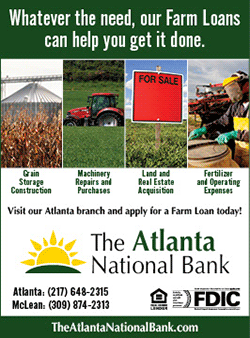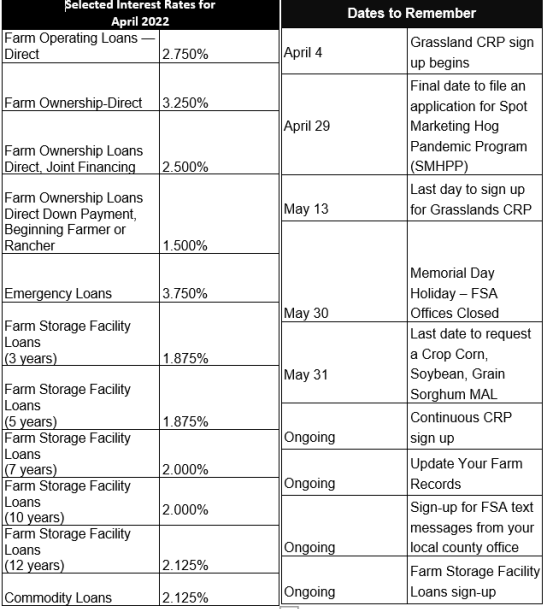|
 The Illinois FSA State Committee was selected and announced on
March 18, 2022. The Illinois FSA State Committee was selected and announced on
March 18, 2022.
The State Committee members are:
• Steve Turner - Chairman - Chandlerville
• Erika Rae Allen - Member - Chicago
• Johari Cole-Kweli - Pembroke
• Ben Curtin - Member - Taylorville
• Brenda Hill - Member - Brookport
I look forward to working with each of them to better serve the
producers in Illinois.
On April 4, 2022 – USDA FSA announced that Grassland CRP sign up
opened.
The Spot Market Hog Pandemic Program (SMHPP) which is part of
USDA’s Pandemic Assistance for Producers initiative and
addresses gaps in previous assistance for hog producers.
FSA is accepting applications December 15, 2021 through April
29, 2022.
May 13, 2022 - Grassland CRP sign up ends May 30, 2022
Memorial Day Holiday - FSA Offices Closed
May 31, 2022 – Last Date to Request 2021Crop Corn, Soybean and
Grain Sorghum Marketing Assistance Loan (MAL)

FSA Ongoing Farm Storage Facility Loans (FSFL) If you are in
interested in increasing on the farm grain storage capacities
and needing to add a new grain bin, grain truck, cold storage
facility, cold storage or refrigerated truck etc., FSA has an
ongoing FSFL loan program with attractive low interest rates.
WHO IS ELIGIBLE?
An eligible borrower is any person who is a landowner, landlord,
leaseholder, tenant or sharecropper. Eligible borrowers must be
able to show repayment ability and meet other requirements to
qualify for a loan.
The April loan rates for FSFL loans are:
3 yrs. = 1.875%
5 yrs. = 1.875%
7 yrs. = 2.00%
10 yrs. = 2.00%
12 yrs. = 2.125%
(Loan rates are subject to change monthly)
Producers do not need to demonstrate the lack of commercial
credit availability to apply.
Please contact your local county FSA office for more information
regarding FSFL loans. As you complete your spring crop planting,
please remember to take that extra step in your every day
routine and continue to stay safe on and around the farm.
Sincerely,
Scott Halpin
State Executive Director

USDA to Provide Payments to Livestock
Producers Impacted by Drought or Wildfire
The U.S Department of Agriculture (USDA)
announced that ranchers who have approved applications through
the 2021 Livestock Forage Disaster Program (LFP) for forage
losses due to severe drought or wildfire in 2021 will soon begin
receiving emergency relief payments for increases in
supplemental feed costs in 2021 through the Farm Service
Agency’s (FSA) new Emergency Livestock Relief Program (ELRP).
Background
On September 30, 2021, President Biden signed into law the
Extending Government Funding and Delivering Emergency Assistance
Act (P.L. 117-43). This Act includes $10 billion in assistance
to agricultural producers impacted by wildfires, droughts,
hurricanes, winter storms and other eligible disasters
experienced during calendar years 2020 and 2021. Additionally,
the Act specifically targets $750 million to provide assistance
to livestock producers for losses incurred due to drought or
wildfires in calendar year 2021. ELRP is part of FSA’s
implementation of the Act.
For impacted producers, USDA will leverage LFP data to deliver
immediate relief for increases in supplemental feed costs in
2021. LFP is an important tool that provides up to 60% of the
estimated replacement feed cost when an eligible drought
adversely impacts grazing lands or 50% of the monthly feed cost
for the number of days the producer is prohibited from grazing
the managed rangeland because of a qualifying wildfire.
FSA received more than 100,000 applications totaling nearly $670
million in payments to livestock producers under LFP for the
2021 program year.

Congress recognized requests for assistance beyond this existing
program and provided specific funding for disaster-impacted
livestock producers in 2021.
ELRP Eligibility – Phase One
To be eligible for an ELRP payment under phase one of program
delivery, livestock producers must have suffered grazing losses
in a county rated by the U.S. Drought Monitor as having a D2
(severe drought) for eight consecutive weeks or a D3 (extreme
drought) or higher level of drought intensity during the 2021
calendar year and have applied and been approved for 2021 LFP.
Additionally, producers whose permitted grazing on federally
managed lands was disallowed due to wildfire are also eligible
for ELRP payments if they applied and were approved for 2021 LFP.
As part of FSA’s efforts to streamline and simplify the delivery
of ELRP phase one benefits, producers are not required to submit
an application for payment; however, they must have the
following forms on file with FSA within a subsequently announced
deadline as determined by the Deputy Administrator for Farm
Programs:
CCC-853, Livestock Forage Disaster Program Application
Form AD-2047, Customer Data Worksheet.
Form CCC-902, Farm Operating Plan for an individual or legal
entity.
Form CCC-901, Member Information for Legal Entities (if
applicable).
Form FSA-510, Request for an Exception to the $125,000 Payment
Limitation for Certain Programs (if applicable).
Form CCC-860, Socially Disadvantaged, Limited Resource,
Beginning and Veteran Farmer or Rancher Certification, if
applicable, for the 2021 program year.
A highly erodible land conservation (sometimes referred to as
HELC) and wetland conservation certification (Form AD-1026
Highly Erodible Land Conservation (HELC) and Wetland
Conservation (WC) Certification) for the ELRP producer and
applicable affiliates.
ELRP Payment Calculation – Phase One
To further expedite payments to eligible livestock producers,
determine eligibility, and calculate an ELRP phase one payment,
FSA will utilize livestock inventories and drought-affected
forage acreage or restricted animal units and grazing days due
to wildfire already reported by the producer when they submitted
a 2021 CCC-853, Livestock Forage Disaster Program Application
form.

Phase one ELRP payments will be equal to the eligible livestock
producer’s gross 2021 LFP calculated payment multiplied by a
payment percentage, to reach a reasonable approximation of
increased supplemental feed costs for eligible livestock
producers in 2021.
The ELRP payment percentage will be 90% for historically
underserved producers, including beginning, limited resource,
and veteran farmers and ranchers, and 75% for all other
producers. These payments will be subject to a payment
limitation.
To qualify for the higher payment percentage, eligible producers
must have a CCC-860, Socially Disadvantaged, Limited Resource,
Beginning and Veteran Farmer or Rancher Certification, form on
file with FSA for the 2021 program year.
Payments to eligible producers through phase one of ELRP are
estimated to total more than $577 million.
ELRP - Phase Two
Today’s announcement is only Phase One of relief for livestock
producers. FSA continues to evaluate and identify impacts of
2021 drought and wildfire on livestock producers to ensure
equitable and inclusive distribution of much-needed emergency
relief program benefits.
Emergency Relief Program (ERP) Assistance for Crop Producers
FSA is developing a two-phased process to provide assistance to
diversified, row crop and specialty crop operations that were
impacted by an eligible natural disaster event in calendar years
2020 or 2021.
This program will provide assistance to crop producers and will
follow a two-phased process similar to that of the livestock
assistance with implementation of the first phase in the coming
weeks. Phase one of the crop assistance program delivery will
leverage existing Federal Crop Insurance or Noninsured Crop
Disaster Assistance Program data as the basis for calculating
initial payments.
Making the initial payments using existing safety net and risk
management data will both speed implementation and further
encourage participation in these permanent programs, including
the Pasture, Rangeland, Forage Rainfall Index Crop Insurance
Program, as Congress intended.

The second phase of the crop program will be intended to fill
additional assistance gaps and cover eligible producers who did
not participate in existing risk management programs.
Through proactive communication and outreach, USDA will keep
producers and stakeholders informed as ERP implementation
details are made available.
Additional Livestock Drought Assistance
Due to the persistent drought conditions in the Great Plains and
West, FSA will be offering additional relief through the
Emergency Assistance for Livestock, Honeybees and Farm-raised
Fish Program (ELAP) to help ranchers cover above normal costs of
hauling livestock to forage. This policy enhancement
complements previously announced ELAP compensation for hauling
feed to livestock. Soon after FSA announced the assistance for
hauling feed to livestock, stakeholders were quick to point out
that producers also were hauling the livestock to the feed
source as well and encouraged this additional flexibility.
It is important to note that, unlike ELRP emergency relief
benefits which are only applicable for eligible losses incurred
in the 2021 calendar year, this ELAP livestock and feed hauling
compensation will not only be retroactive for 2021 but will also
be available for losses in 2022 and subsequent years.
To calculate ELAP program benefits, an online tool is currently
available to help producers document and estimate payments to
cover feed transportation cost increases caused by drought and
will soon be updated to assist producers with calculations
associated with drought related costs incurred for hauling
livestock to forage.
More Information
Additional USDA disaster assistance information can be found on
farmers.gov, including USDA resources specifically for producer
impacted by drought and wildfire and the Disaster Assistance
Discovery Tool, Disaster-at-a-Glance fact sheet, and Farm Loan
Discovery Tool. For FSA and Natural Resources Conservation
Service programs, producers should contact their local USDA
Service Center. For assistance with a crop insurance claim,
producers and landowners should contact their crop insurance
agent.

USDA Updates Eligibility for Spot Market Hog
Pandemic Program
The U.S. Department of Agriculture (USDA) has
clarified the definition of a spot market sale and hog
eligibility under the Spot Market Hog Pandemic Program (SMHPP),
which assists producers who sold hogs through a spot market sale
from April 16, 2020, through Sept. 1, 2020. Hog producers will
also now be required to submit documentation to support
information provided on their SMHPP application. USDA’s Farm
Service Agency (FSA) will accept applications through April 29,
2022, which is an extension of the April 15, 2022, deadline
previously set for the program.
USDA is offering the SMHPP in response to a reduction in packer
production due to the COVID-19 pandemic, which resulted in fewer
negotiated hogs being procured and subsequent lower market
prices. The program is part of USDA’s broader Pandemic
Assistance for Producers initiative and addresses gaps in
previous assistance for hog producers.
SMHPP Program Updates
When the pandemic disrupted normal marketing channels, including
access to packers, producers sold their hogs through cash sales
to local processors or butchers, direct sales to individuals and
third-party intermediaries, including sale barns or brokers. The
use of third-party intermediaries was the only available
marketing alternative for many producers and are now included in
SMHPP. The only direct to packer sales that are eligible for
SMHPP are those through a negotiated sale. Hogs sold through a
contract that includes a premium above the spot-market price or
other formula such as the wholesale cut-out price remain
ineligible. Hogs must be suitable and intended for slaughter to
be eligible. Immature swine (pigs) are ineligible.
FSA will now require documentation to support the accuracy of
information provided on the FSA-940 Spot Market Hog Pandemic
Program application, including the number of hogs reported on
the application that were sold through a spot market sale and
how the price was determined for the sale.

SMHPP payments will be calculated by multiplying the number of
head of eligible hogs, not to exceed 10,000 head, by the payment
rate of $54 per head. To ensure SMHPP funding availability is
disbursed equitably to all eligible producers, FSA will now
issue payments after the application period ends. If calculated
payments exceed the amount of available funding, payments will
be factored.
Applying for Assistance
Eligible hog producers can apply for SMHPP by April 29, 2022, by
completing the FSA-940, Spot Market Hog Pandemic Program
application, along with required supporting documentation.
Producers can visit farmers.gov/smhpp for examples of supporting
documentation, information on applicant eligibility and more
information on how to apply.
Applications can be submitted to the FSA office at any USDA
Service Center nationwide by mail, fax, hand delivery or via
electronic means. To find their local FSA office, producers
should visit farmers.gov/service-locator. Hog producers can also
call 877-508-8364 to speak directly with a USDA employee ready
to offer assistance.
Borrower Training for Farm Loan Customers
Borrower training is available for all Farm
Service Agency (FSA) customers. This training is required for
all direct loan applicants, unless the applicant has a waiver
issued by the agency.
Borrower training includes instruction in production and
financial management. The purpose is to help the applicants
develop and improve skills that are necessary to successfully
operate a farm and build equity in the operation. It aims to
help the producer become financially successful. Borrower
training is provided, for a fee, by agency approved vendors.
Contact your local FSA Farm Loan Manager for a list of approved
vendors.
USDA Updates Crop Insurance to Respond to
Producer Needs, Support Conservation and Climate Mitigation
Efforts
The U.S. Department of Agriculture (USDA) is making updates to
crop insurance to respond to the needs of agricultural
producers, including organic producers, as well as to support
conservation of natural resources on agricultural land.

Specifically, USDA’s Risk Management Agency (RMA) is making
permanent a new provision that allows producers to hay, graze or
chop cover crops and still receive a full prevented planting
payment. To accommodate the different farming practices across
the country, RMA is also increasing flexibility related to the
prevented planting “1 in 4” requirement, as well as aligning
crop insurance definitions with USDA’s National Organic
Program.
Haying, Grazing, and Chopping of Cover Crops
In July, RMA announced producers can hay, graze, or chop cover
crops for silage, haylage, or baleage at any time and still
receive 100% of the prevented planting payment. Previously,
cover crops could only be hayed, grazed or chopped after
November 1. Otherwise, the prevented planting payment was
reduced by 65% if producers took those actions on the cover
crop.
RMA added this flexibility starting with the 2021 crop year as
part of a broader effort to encourage producers to use
cover crops, an important conservation and good farming
practice. Cover crops are especially important on fields
prevented from being planted because they cover ground that
would otherwise be left bare, which helps reduce soil
erosion, boost soil health and increase soil carbon
sequestration.
This change builds on the advanced research and identified
benefits cover crops have supporting healthy soils and cropland
sustainability efforts. Studies also show that cover crops
provide increased corn and soybean yields. While results vary by
region and soil type, cover crops are proven to reduce erosion,
improve water quality and increase the health and productivity
of the soil while building resilience to climate change.
Additionally, RMA provided a premium benefit to producers who
planted cover crops through the Pandemic Cover Crop Program to
help producers maintain cover crop systems amid the financially
challenging pandemic.

“1 in 4” Requirement Flexibilities
For the 2020 crop year, RMA implemented a policy stating that
for land to be eligible for prevented planting coverage, the
acreage must meet the “1 in 4” requirement, which means the land
must be planted, insured and harvested in at least one of the
four most recent crop years. Now, RMA is adding flexibilities to
recognize different farming practices and crops grown, as well
as the availability of risk management options.
New flexibilities allowed in order to meet the “1 in 4”
requirement include:
The annual regrowth for an insured perennial crop, such as
alfalfa, red clover, or mint, to be considered planted.
Allow a crop covered by the Noninsured Crop Disaster Assistance
Program (NAP) to meet the insurability requirement.
If crop insurance or NAP coverage was not available, allow the
producer to prove the acreage was planted and harvested using
good farming practices in at least two consecutive years out of
the four previous years to meet the insurability requirement.
Aligning Organic Terms
RMA is revising four organic definitions to be consistent with
USDA’s National Organic Program. Consistency across USDA
programs is important to eliminate the potential for confusion
between the various programs that USDA is committed to providing
to the producers.
This change builds on other RMA efforts to expand and improve
current options for organic producers. In Sept. 2021, RMA
announced several updates to Whole-Farm Revenue Protection (WFRP),
including increasing farm operation growth limits for organic
producers to the higher of $500,000 or 35% over the five-year
average allowable income, and to allowing a producer to report
acreage as certified organic, or as acreage in transition to
organic, when the producer has requested an organic
certification by the acreage reporting date. In addition, RMA
announced it will be offering the new Micro Farm policy through
WFRP that specifically targets coverage for small, diversified
farmers, including organic growers.
Other Changes
RMA made other changes to Common Crop Insurance Policy Basic
Provisions, Area Risk Protection Insurance Regulations, Coarse
Grains Crop Insurance Provisions, and other insurance
provisions, which published today:
RMA is providing an option for producers to delay measurement of
farm-stored production for 180-days through the Special
Provisions, similar to flexibilities already available to grain
crop producers.
RMA added earlage and snaplage as an acceptable method of
harvest for coarse grains. During the 2020 Derecho, many
producers salvaged their damaged corn crop by harvesting as earlage
or snaplage instead of grain or silage.
[to top of second column] |

Crop insurance is sold and delivered solely through private crop
insurance agents. A list of crop insurance agents is available
at all USDA Service Centers and online at the RMA Agent Locator.
Learn more about crop insurance and the modern farm safety net
at rma.usda.gov.
Farm Storage Facility Loans
FSA’s Farm Storage Facility Loan (FSFL) program
provides low-interest financing to producers to build or upgrade
storage facilities and to purchase portable (new or used)
structures, equipment and storage and handling trucks.
The low-interest funds can be used to build or upgrade permanent
facilities to store commodities. Eligible commodities include corn,
grain sorghum, rice, soybeans, oats, peanuts, wheat, barley, minor
oilseeds harvested as whole grain, pulse crops (lentils, chickpeas,
and dry peas), hay, honey, renewable biomass, fruits, nuts and
vegetables for cold storage facilities, floriculture, hops, maple
sap, rye, milk, cheese, butter, yogurt, meat and poultry
(unprocessed), eggs, and aquaculture (excluding systems that
maintain live animals through uptake and discharge of water).
Qualified facilities include grain bins, hay barns and cold storage
facilities for eligible commodities.
Loans up to $50,000 can be secured by a promissory
note/security agreement and loans between $50,000 and $100,000 may
require additional security. Loans exceeding $100,000 require
additional security.
Producers do not need to demonstrate the lack of commercial credit
availability to apply. The loans are designed to assist a diverse
range of farming operations, including small and mid-sized
businesses, new farmers, operations supplying local food and farmers
markets, non-traditional farm products, and underserved producers.
To learn more about the FSA Farm Storage Facility Loan, visit
www.fsa.usda.gov/pricesupport or contact your local FSA county
office. To find your local FSA county office, visit
http://offices.usda.gov.

Keeping Livestock Inventory Records
Livestock inventory records are necessary in the
event of a natural disaster, so remember to keep them updated.
When disasters strike, the USDA Farm Service Agency (FSA) can help
you if you’ve suffered excessive livestock death losses and grazing
or feed losses due to eligible natural disasters.
To participate in livestock disaster assistance programs, you’ll be
required to provide verifiable documentation of death losses
resulting from an eligible adverse weather event and must submit a
notice of loss to your local FSA office within 30 calendar days of
when the loss of livestock is apparent. For grazing or feed losses,
you must submit a notice of loss to your local FSA office within 30
calendar days of when the loss is apparent and should maintain
documentation and receipts.
You should record all pertinent information regarding livestock
inventory records including:
Documentation of the number, kind, type, and weight range of
livestock
Beginning inventory supported by birth recordings or purchase
receipts.
Producers are encouraged to file acreage reports which include
pasture and hayland acres to ensure eligibility for current and
future programs. For more information on documentation requirements,
contact your local County USDA Service Center or visit fsa.usda.gov.

Reminders for FSA Direct and Guaranteed
Borrowers with Real Estate Security
Farm loan borrowers who have pledged real estate as
security for their Farm Service Agency (FSA) direct or guaranteed
loans are responsible for maintaining loan collateral. Borrowers
must obtain prior consent or approval from FSA or the guaranteed
lender for any transaction that affects real estate security. These
transactions include, but are not limited to:
Leases of any kind
Easements of any kind
Subordinations
Partial releases
Sales
Failure to meet or follow the requirements in the loan agreement,
promissory note, and other security instruments could lead to
nonmonetary default which could jeopardize your current and future
loans.
It is critical that borrowers keep an open line of communication
with their FSA loan staff or guaranteed lender when it comes to
changes in their operation. For more information on borrower
responsibilities, read Your FSA Farm Loan Compass.
Reporting Organic Crops
If you want to use the Noninsured Crop Disaster
Assistance Program (NAP) organic price and you select the "organic"
option on your NAP application, you must report your crops as
organic.
When certifying organic acres, the buffer zone acreage must be
included in the organic acreage.
You must also provide a current organic plan, organic certificate or
documentation from a certifying agent indicating an organic plan is
in effect. Documentation must include:
name of certified individuals
address
telephone number
effective date of certification
certificate number
list of commodities certified
name and address of certifying agent
a map showing the specific location of each field of certified
organic, including the buffer zone acreage

Certification exemptions are available for
producers whose annual gross agricultural income from organic sales
totals $5,000 or less. Although exempt growers are not required to
provide a written certificate, they are still required to provide a
map showing the specific location of each field of certified
organic, transitional and buffer zone acreage.
Filing CCC-941 Adjusted Gross Income
Certifications
If you have experienced delays in receiving
Agriculture Risk Coverage (ARC) and Price Loss Coverage (PLC)
payments, Loan Deficiency Payments (LDPs) and Market Gains on
Marketing Assistance Loans (MALs), it may be because you have not
filed form CCC-941, Adjusted Gross Income Certification.
If you don’t have a valid CCC-941 on file for the applicable crop
year you will not receive payments. All farm operator/tenants/owners
who have not filed a CCC-941 and have pending payments should
IMMEDIATELY file the form with their recording county FSA office.
Farm operators and tenants are encouraged to ensure that their
landowners have filed the form.
FSA can accept the CCC-941 for 2018, 2019, 2020, 2021, and 2022.
Unlike the past, you must have the CCC-941 certifying your AGI
compliance before any payments can be issued.
More information on adjusted gross income is available at Payment
Eligibility (usda.gov).
A Message from the State Conservationist
The U.S. Department of Agriculture (USDA) unveiled
a new plan to help guide voluntary conservation work over the next
five years across 25 states, including over 7 million acres of new
conservation practices on productive, working lands, and will
contribute to the current Administration’s efforts to make our
nation a leader on climate change mitigation, adaptation and
resilience. Illinois is one of those states.
The plan will accelerate voluntary conservation efforts for the
Northern bobwhite quail and the grassland and savanna landscapes
that the species calls home. This plan, the Northern Bobwhite,
Grasslands and Savannas Framework for Conservation Action, outlines
how USDA’s Natural Resources Conservation Service (NRCS) will work
with agricultural producers and partners like Quail Forever to
increase adoption of targeted conservation practices that are good
for farmers, the bobwhite, and natural resources. This framework
leverages conservation efforts on working lands and supports the
Administration’s America the Beautiful initiative.

“When we manage for bobwhite habitat, we can also create healthier
forests and forage, which is good for livestock producers,
landowners, and natural resources,” said Ivan Dozier, NRCS State
Conservationist in Illinois. “This new framework builds on what we
know – that America’s agricultural producers using conservation
practices are helping declining species like the bobwhite while also
providing food and fiber and conserving our resources for future
generations. In the face of weather extremes, as well as habitat
loss and fragmentation, expanding efforts to conserve landscapes and
wildlife communities is more important than ever.”
“Quail Forever recognizes the need to help landowners build farming
systems that match profitability with ecological performance;
supporting the bottom line of farmers and ranchers while
contributing to a habitat mosaic that creates positive gains for
bobwhite quail and other species,” said Ron Leathers, Chief
Conservation Officer for Quail Forever. “To that end, we’re proud to
partner with the United States Department of Agriculture in this
endeavor and look forward to assisting producers with the
implementation of working lands programs that provide incredible
gains for wildlife, water quality, farm profitability, climate
resiliency, and soil health.”
The framework:
Reduces threats, like drought and wildfire, to grassland and savanna
landscapes that northern bobwhite and other species call home.
Establishes native warm-season grasses to reduce erosion, recharge
aquifers and supplement forage during summer slump periods.
Focuses on key conservation practices, including prescribed grazing,
brush management, prescribed burning, herbaceous weed treatment,
forage and biomass planting, contour buffer strips and forest stand
improvement.
Leverages support from partners like Quail Forever to help producers
with planning and implementing practices.

Monitors and measures the response of northern bobwhite and other
wildlife species through the Northern Bobwhite Technical Committee (NBTC)
and Quail Forever.
Develops landscape-wide models to track wildlife and economic
outcomes by researchers at the University of Georgia and Mississippi
State University.
Develops outcomes assessments that include quantifying tons of
carbon stored because of conservation efforts to mitigate harmful
greenhouse gases.
How Landowners Can Get Involved
Farmers, livestock operators, and private landowners in the Midwest
can work with NRCS to implement conservation practices on their
working lands, including those that further this new framework. To
learn more, they should contact their local USDA Service Center.
USDA Encourages Producers to Enroll in Grassland
CRP
The U.S. Department of Agriculture (USDA)
encourages producers and landowners to enroll in the Grassland
Conservation Reserve Program (CRP) starting April 4, 2022 through
May 13, 2022. Grassland CRP provides a unique opportunity for
farmers, ranchers, and agricultural landowners to keep land in
agricultural production and supplement their income while improving
their soils and permanent grass cover. The program had its highest
enrollment in history in 2021 and is part of the Biden-Harris
Administration’s broader effort to equip producers with the tools
they need to help address climate change and invest in the long-term
health of our natural resources.
Grassland CRP is a federally funded voluntary working lands program.
Through the program, USDA’s Farm Service Agency (FSA) provides
annual rental payments to landowners to maintain and conserve
grasslands while allowing producers to graze, hay, and produce seed
on that land. Maintaining the existing permanent cover provides
several benefits, including reducing erosion, providing wildlife
habitat and migration corridors, and capturing and maintaining
carbon in the soil and cover.
FSA provides participants with annual rental payments and cost-share
assistance. The annual rental rate varies by county with a national
minimum rental rate of $13 per acre for this signup. Contract
duration is 10 or 15 years.

Grassland CRP National Priority Zones
Because Grassland CRP supports not only grazing operations but also
biodiversity and conserving environmentally sensitive land such as
that prone to wind erosion, FSA created two National Priority Zones
in 2021: the Greater Yellowstone Migration Corridor and Dust Bowl
Zone. As part of the Biden-Harris Administration’s focus on
conservation in important wildlife corridors and key seasonal
ranges, for this year’s signup, FSA is expanding the Greater
Yellowstone Wildlife Migration Corridor Priority Zone to include
seven additional counties across Montana, Wyoming, and Utah, to help
protect the big-game animal migration corridor associated with
Wyoming elk, mule deer, and antelope.
Offers within one of these National Priority Zones will receive an
additional 15 ranking points and $5 per acre if at least 50% of the
offer is located in the zone.
Alongside Grassland CRP, producers and landowners can also enroll
acres in Continuous CRP under the ongoing sign up, which includes
projects available through the Conservation Reserve Enhancement
Program (CREP) and State Acres for Wildlife Enhancement (SAFE).
Broadening Reach of Program
As part of the Agency’s Justice40 efforts, producers and landowners
who are historically underserved, including beginning farmers and
military veterans, will receive 10 additional ranking points to
enhance their offers.
Additionally, USDA is working to broaden the scope and reach of
Grassland CRP by leveraging the Conservation Reserve Enhancement
Program (CREP) to engage historically underserved communities. CREP
is a partnership program that enables states, Tribal governments,
non-profit, and private entities to partner with FSA to implement
CRP practices and address high priority conservation and
environmental objectives. Interested entities are encouraged to
contact FSA.
More Information on CRP
Landowners and producers interested in Grassland CRP should contact
their local USDA Service Center to learn more or to apply for the
program before the May 13, 2022 deadline. Additionally, fact sheets
and other resources are available at fsa.usda.gov/crp.

Signed into law in 1985, CRP is one of the largest voluntary
private-lands conservation programs in the United States. The
working lands signup announced today demonstrates how much it has
evolved from the original program that was primarily intended to
control soil erosion and only had the option to take enrolled land
out of production. The program has expanded over the years and now
supports a greater variety of conservation and wildlife benefits,
along with the associated economic benefits.
Environmental Review Required Before Project
Implementation
The National Environmental Policy Act (NEPA)
requires Federal agencies to consider all potential environmental
impacts for federally-funded projects before the project is
approved.
For all Farm Service Agency (FSA) programs, an environmental review
must be completed before actions are approved, such as site
preparation or ground disturbance. These programs include, but are
not limited to, the Emergency Conservation Program (ECP), Farm
Storage Facility Loan (FSFL) program and farm loans. If project
implementation begins before FSA has completed an environmental
review, the request will be denied. Although there are exceptions
regarding the Stafford Act and emergencies, it’s important to wait
until you receive written approval of your project proposal before
starting any actions.
Applications cannot be approved until FSA has copies of all permits
and plans. Contact your local FSA office early in your planning
process to determine what level of environmental review is required
for your program application so that it can be completed timely.
Transitioning Expiring CRP Land to Beginning,
Veteran or Underserved Farmers and Ranchers
CRP contract holders are encouraged to transition
their Conservation Reserve Program (CRP) acres to beginning, veteran
or socially disadvantaged farmers or ranchers through the Transition
Incentives Program (TIP). TIP provides annual rental payments to the
landowner or operator for up to two additional years after the CRP
contract expires.

CRP contract holders no longer need to be a retired or retiring
owner or operator to transition their land. TIP participants must
agree to sell, have a contract to sell, or agree to lease long term
(at least five years) land enrolled in an expiring CRP contract to a
beginning, veteran, or socially disadvantaged farmer or rancher who
is not a family member.
Beginning, veteran or social disadvantaged farmers and ranchers and
CRP participants may enroll in TIP beginning two years before the
expiration date of the CRP contract. The TIP application must be
submitted prior to completing the lease or sale of the affected
lands. New landowners or renters that return the land to production
must use sustainable grazing or farming methods.
For more information, contact your local County USDA Service Center
or visit fsa.usda.gov.
Update Your Records
FSA is cleaning up our producer record database and
needs your help. Please report any changes of address, zip code,
phone number, email address or an incorrect name or business name on
file to our office. You should also report changes in your farm
operation, like the addition of a farm by lease or purchase. You
should also report any changes to your operation in which you
reorganize to form a Trust, LLC or other legal entity.
FSA and NRCS program participants are required to promptly report
changes in their farming operation to the County Committee in
writing and to update their Farm Operating Plan on form CCC-902.
Maintaining the Quality of Farm-Stored Loan
Grain
Bins are ideally designed to hold a level volume of
grain. When bins are overfilled and grain is heaped up, airflow is
hindered and the chance of spoilage increases.
Producers who take out marketing assistance loans and use the
farm-stored grain as collateral should remember that they are
responsible for maintaining the quality of the grain through the
term of the loan.
Unauthorized Disposition of Grain
If loan grain has been disposed of through feeding,
selling or any other form of disposal without prior written
authorization from the county office staff, it is considered
unauthorized disposition. The financial penalties for unauthorized
dispositions are severe and a producer’s name will be placed on a
loan violation list for a two-year period. Always call before you
haul any grain under loan.
April Interest Rates and Important Dates

CLICK TO ENLARGE
[Illinois/ FPAC]
 |